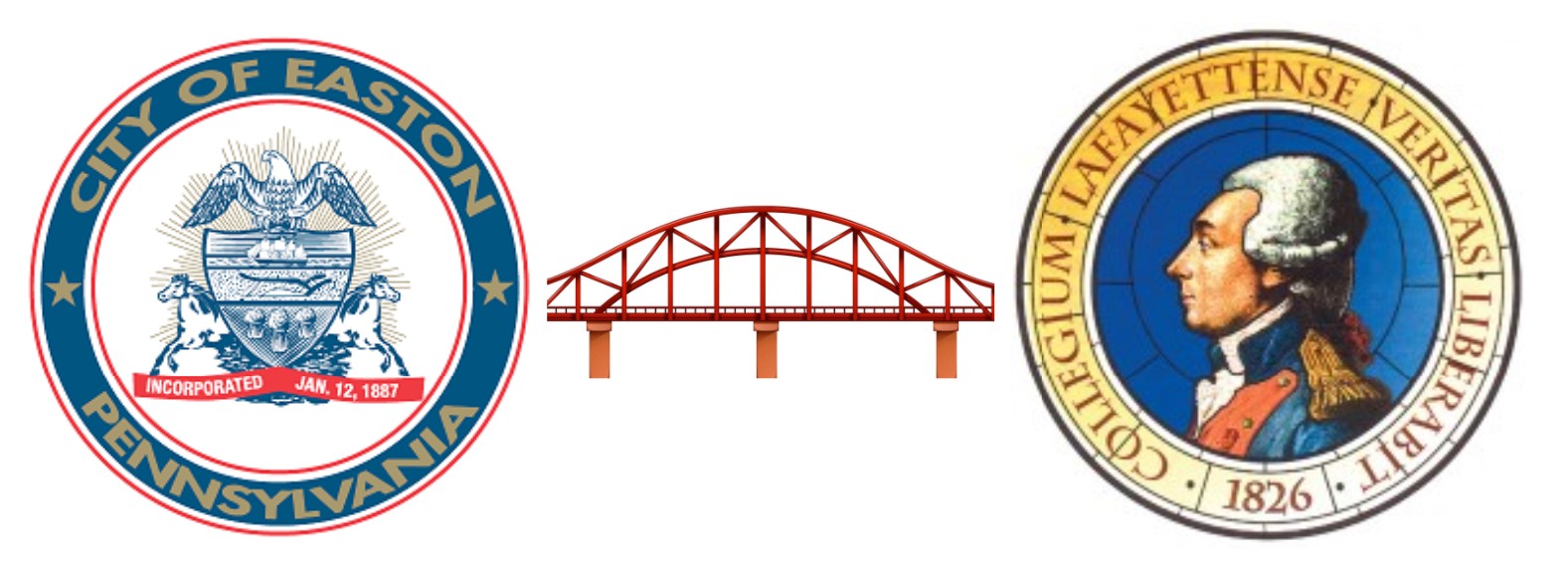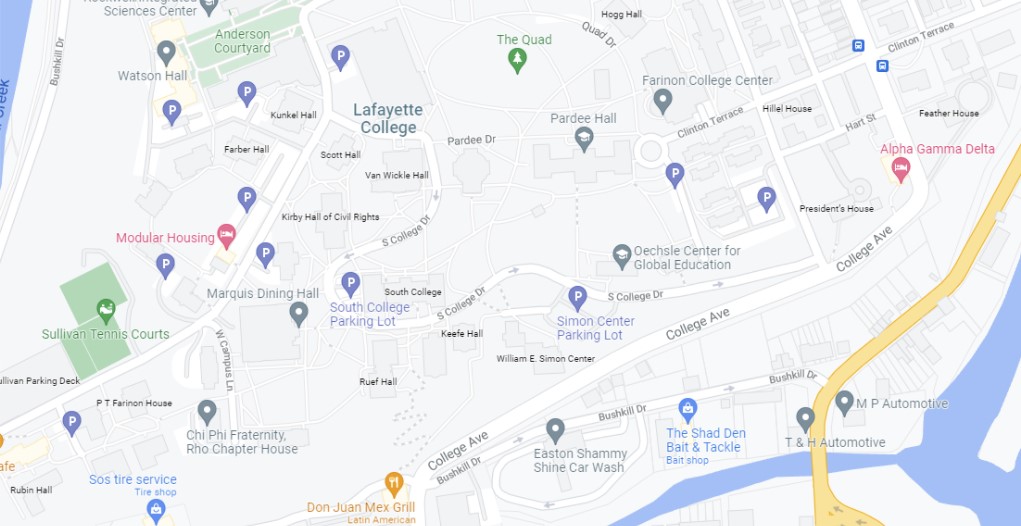There is not an accessible and safe way to walk, bike, or run to or from College Hill or the Lafayette campus to Downtown Easton or the Lafayette arts campus. It is dangerous and difficult to navigate the hill on the best of days, and it becomes exceedingly difficult to do so with poor weather conditions and reduced visibility. Our group’s proposed solution is a trail revitalization and extension connecting to the Karl Stirner Arts Trail, as well as a bridge spanning College Ave or Bushkill Drive, which will help to develop a closer relationship between Lafayette College and the Easton community.

Figure 1: Trail and bridge system spanning College Ave

Figure 2: Trail and bridge system spanning Bushkill Drive
While the physical design of the bridges are still in a preliminary stage, we have no shortage of ideas for them. We will incorporate the rich history of the area, from the converging rivers to the trolleys, and use those as inspiration to create something that will physically and socially connect the Lafayette and Easton communities. It is also extremely important to note that these designs are in no way final or meant to be wholly representative of what the finished product may look like in the future. These are our thoughts on it before receiving input from the Easton community or the Lafayette student body, whose thoughts and feelings on the project will play an intrinsic role in its design and creation.

Figure 3: Our logo, bridging the gap between Easton and Lafayette
There is both a social and physical disconnect between Lafayette and the downtown Easton/Arts campus. This disconnect stems from many issues including physical barriers, college elitism, a technical mindset, and systemic racism/classism including redlining and gentrification. This proposal will improve this socio-technical relationship through a bridge design that promotes accessibility and connectivity by addressing the current social barriers in place. Our proposal will create a framework for the school and community to continue in a collaborative design process that will meet the needs of all parties involved. Our design is a jumping–off point, addressing some of the major concerns such as bridge location, Americans with Disabilities Act (ADA) compliance, adaptive reuse of existing trails, budgeting, and more. We are presenting multiple options for locations as well, which will be talked about further on in our technical analysis.
There were many challenges we overcame in the design of a pedestrian bridge. We always kept the budget and the scope of this proposal in mind and constrained our design to be as affordable as we could reasonably make it. Safety and accessibility were two of the most important and most vital concerns for us to deal with. Scaling the hill without a car is incredibly difficult for anyone, whether they have a disability or not, so our design absolutely had to address this for it to be successful. Additionally, we had to keep the design appropriately sized to be able to achieve the goals in place but not be so large and gaudy as to be off-putting.
The aesthetics of the bridge are important as well and required a great deal of research into local history, as well as consulting with the art department and facilities planning to ensure that the design pays homage to Easton and the Bushkill Creek area, while also fitting in with the aesthetics of the school. This will be a vitally important area to later welcome opinions and ideas from Easton residents. They are a key group to consider, and this proposal must be beneficial to them along with Lafayette students. Ensuring that the entrances to the bridge are welcoming to residents was an important part of the aesthetic choices which we could not afford to overlook.
Going hand in hand with the aesthetics of the design is integrating the bridge into the existing terrain, which proved to be a challenge to our design proposal. As none of us are civil engineers, architects, or artists we cast a wide net and met with many members of the Lafayette faculty, Professor Mary Wilford-Hunt, the head of facilities operations, Professor David Mante, and Professor Mark McGuire from the Civil Engineering Department, Professor Nestor Gil from the art department, and Professor Kristen Sanford from the Engineering Studies department. These professors have expert knowledge in planning, school history, architecture, design, civil engineering, and transit and traffic planning to help us figure out potential solutions.
According to Professor Wilford-Hunt, making use of existing trails and unkempt infrastructure already in place is a great opportunity for the school to revamp and reuse some of the lands which it already owns, and make the entrance to the college more inviting and exciting. There are of course more actors at play than just the college and Easton residents. We learned from Professor Sanford that College Ave, the road that leads directly up the hill to the school, is owned by the Pennsylvania Department of Transportation (PennDOT). In order to do anything that spans that road we had to ensure that we understood what was required to have PennDOT allow us to construct something spanning College Ave. In our meeting with Professor McGuire, we learned that this road has been a catching point for previous capstone projects in the civil engineering department, which made it vital for us to make sure any bridge design meets the proper clearance of the road to allow trucks and other large vehicles to pass through unhindered.

Figure 4: College Ave, located to the south of Lafayette’s campus, has been a catching point for proposals in the past.
Research of the history of the area has been conducted by our group to get a good grasp on what the needs are and how we hope to address them. With so much vitriol between the college and local Eastonians in recent years regarding college expansionism (Gaffney, 2017), we wanted to prioritize and emphasize the community through this project and develop something that people can get behind. In order to accomplish this the community must be included in every step of the design process should the project take hold. Funding this project and keeping costs in check was of course one of the most important issues for us to address. Fortunately, the school has received grant money in the past for the infamous ‘Skyway’ project (Tatu, 2018), so we will have some money to work with. Professor Wilford-Hunt confirmed for us that the money granted towards the Skyway project is still available.
Balancing the needs of Lafayette students, staff, administration, and faculty with the greater Easton community is the crux of this issue. College expansionism has been generally looked down upon by the Easton community (Gaffney, 2017), so ensuring that the needs of all parties are addressed is vital. Balancing competing viewpoints will be key in the future of this project, as approval from many different groups must be granted to have this proposal succeed. Additionally, we made ourselves familiar with local ordinances and zoning, our plan will go nowhere if the dimensions of our designs are disallowed.
The construction of a pathway spanning College Avenue will be challenging due to the sheerness of the ground it will be built on. As of the submission of this proposal, the design for the bridge will cross College Avenue from Williams Visual Arts center directly north to the appropriate elevation on the hill. We selected our construction material based on the impact it will have on its environment, its sustainability, and aesthetic appeal. The function of this bridge will be to connect students and residents from McCartney Street and the Simon Center to Ahart Plaza. We will try to incorporate all forms of accessibility if possible.
Funding for this project will largely come from the College’s resources itself with the inclusion of existing state and city contributions. Costs will include the construction of the bridge and all its aspects such as labor, materials, and equipment. Maintenance and possible revisions will require funds throughout the structure’s lifespan as well. Currently, a concrete estimate is difficult to arrive at, but the project will be in the millions of dollars. While this is not a profit-minded project it will attract a greater image for Lafayette and may indirectly result in more financial contributions. The walking bridge could also be a major draw for a potential donor, which could ease the financial burden greatly.